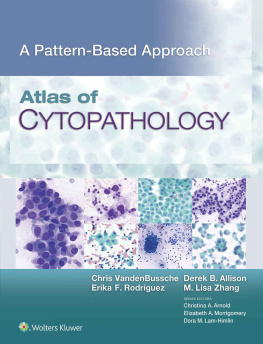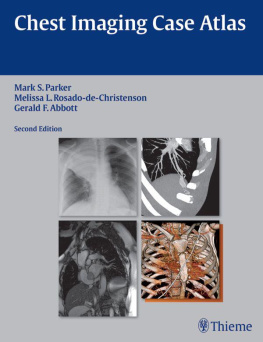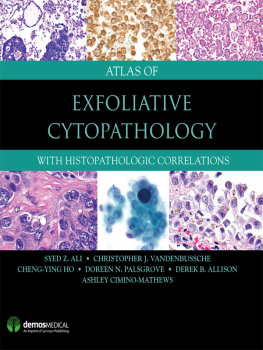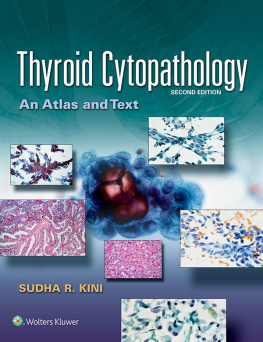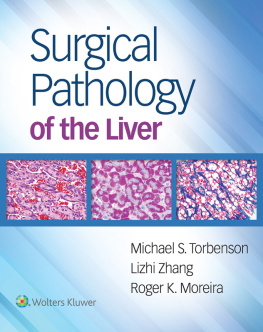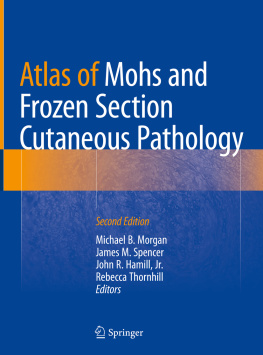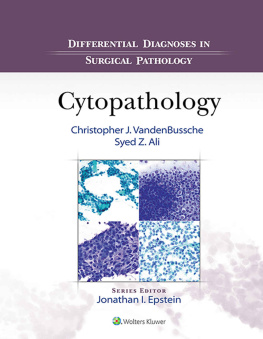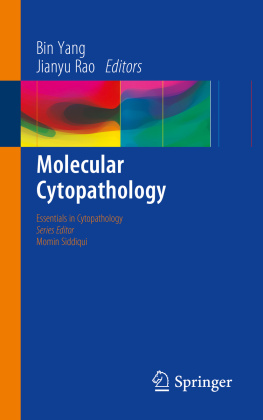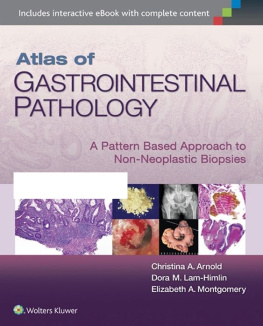Atlas of CytopathologyA Pattern Based Approach
Christopher J. VandenBussche
Erika F. Rodriguez
Derek B. Allison
M. Lisa Zhang
Copyright
Acquisitions Editor: Keith Donnellan
Development Editor: Ariel S. Winter
Editorial Coordinator: Tim Rinehart
Marketing Manager: Julie Sikora
Production Project Manager: Kim Cox
Design Coordinator: Holly McLaughlin
Manufacturing Coordinator: Beth Welsh
Prepress Vendor: TNQ Technologies
Copyright 2020 Wolters Kluwer.
All rights reserved. This book is protected by copyright. No part of this book may be reproduced or transmitted in any form or by any means, including as photocopies or scanned-in or other electronic copies, or utilized by any information storage and retrieval system without written permission from the copyright owner, except for brief quotations embodied in critical articles and reviews. Materials appearing in this book prepared by individuals as part of their official duties as U.S. government employees are not covered by the above-mentioned copyright. To request permission, please contact Wolters Kluwer at Two Commerce Square, 2001 Market Street, Philadelphia, PA 19103, via email at (products and services).
987654321
Printed in China
Library of Congress Cataloging-in-Publication Data
ISBN-13: 978-1-4963-9704-1
Cataloging-in-Publication data available on request from the Publisher.
This work is provided as is, and the publisher disclaims any and all warranties, express or implied, including any warranties as to accuracy, comprehensiveness, or currency of the content of this work.
This work is no substitute for individual patient assessment based upon healthcare professionals examination of each patient and consideration of, among other things, age, weight, gender, current or prior medical conditions, medication history, laboratory data and other factors unique to the patient. The publisher does not provide medical advice or guidance and this work is merely a reference tool. Healthcare professionals, and not the publisher, are solely responsible for the use of this work including all medical judgments and for any resulting diagnosis and treatments.
Given continuous, rapid advances in medical science and health information, independent professional verification of medical diagnoses, indications, appropriate pharmaceutical selections and dosages, and treatment options should be made and healthcare professionals should consult a variety of sources. When prescribing medication, healthcare professionals are advised to consult the product information sheet (the manufacturers package insert) accompanying each drug to verify, among other things, conditions of use, warnings and side effects and identify any changes in dosage schedule or contraindications, particularly if the medication to be administered is new, infrequently used or has a narrow therapeutic range. To the maximum extent permitted under applicable law, no responsibility is assumed by the publisher for any injury and/or damage to persons or property, as a matter of products liability, negligence law or otherwise, or from any reference to or use by any person of this work.
shop.lww.com
Dedication
To Cherry and Josephine.
Christopher J. VandenBussche, MD, PhD
To Fausto, Olivia, and Melissa.
Erika F. Rodriguez, MD, PhD
To Catherine, my wife, hero, and best friend.
To Wesley and Avery, the world is yours for the taking!
Derek B. Allison, MD
To Alan, my forever best friend and biggest supporter.
M. Lisa Zhang, MD
Preface
The challenges of cytopathology are difficult to capture in a textbook; in reality, most melanoma cells do not contain pigment, air-drying artifacts alter cytomorphology, and benign respiratory cells may obscure lung carcinoma cells. Specimens of borderline adequacy leave one to question whether a definitive diagnosis can be made. Most cytopathology textbooks present us with ideal cellsthe best cells photographed from the best specimens. In reality, these ideal cells may not be seen, nor are they required for a proper diagnosis. In many instances, ideal cells may even be insufficient for a diagnosis if not seen in a particular pattern or context.
This atlas presents more than 1500 representative high-quality images. Rather than focus on obscure diagnoses, numerous images from frequently seen diagnoses are included to cover the different preparations, artifacts, and limitations seen during a cytopathology sign out. The most commonly encountered pitfalls are also provided, as well as advice on when and how to hedge.
Rather than focus strictly on single cells, this atlas acknowledges the importance of pattern recognition in cytopathology. The different cell populations and background material seen in a specimen may form a pattern that leads to a specific diagnosis. An experienced cytopathologist must learn to absorb microscopic fields full of cells, as examining each individual cell in a specimen is not possible.
The text is high yield and focused on checklists, key features, diagnostic pearls and pitfalls, frequently asked questions, and sample notes, all further described below.
- Each chapter opens with a Chapter Checklist that outlines the enclosed structure and allows the reader to quickly hone in on select patterns and pertinent differential considerations. Similar Checklists are found throughout the chapter to neatly organize complicated topics.
- The Unremarkable X: Depending on the type of specimen, normal background cells may or may not be commonly seen. In instances where background cells are present, they may contain changes that can confound a diagnosis. In instances where background cells are unexpected, they may be mistaken as lesional cells. This section provides a description of the normal background cells that may be seen in each specimen type.
- The Pearls & Pitfalls sections include lessons from real life sign out experience with an emphasis on important diagnostic clues, mimics, and hazards.
- The Frequently Asked Questions sections stem from our busy consult service and teaching sessions. In this section, we discuss real-life diagnostic dilemmas and offer diagnostic tips and tools to sort through commonly encountered sign-out challenges.
- All major topics close with a Key Features section that summarizes the essential elements of the subtopic for handy reference.
- A Sample Note section accompanies the more challenging topics. In these sections, an example cytopathology report is included with the top-line diagnoses, including pertinent discussion and salient references. These Notes offer a template of how to synthesize complicated topics and are based on real-life cases and interactions with clinicians. The select references are included for those interested in further reading but can also be included in pathology reports to help guide clinical management.
- Self-Assessment Questions appear as an appendix at the end of the book and as an interactive Quiz online to emphasize important teaching points. These sections offer the reader experience and confidence with high-yield teaching topics. Questions are in the format of the board-type examinations and can also serve as useful board preparatory materials.
Acknowledgments
The authors thank Dr. Morgan Cowan for reviewing select chapters and Dr. Austin McCuiston for test-driving the chapter questions.

